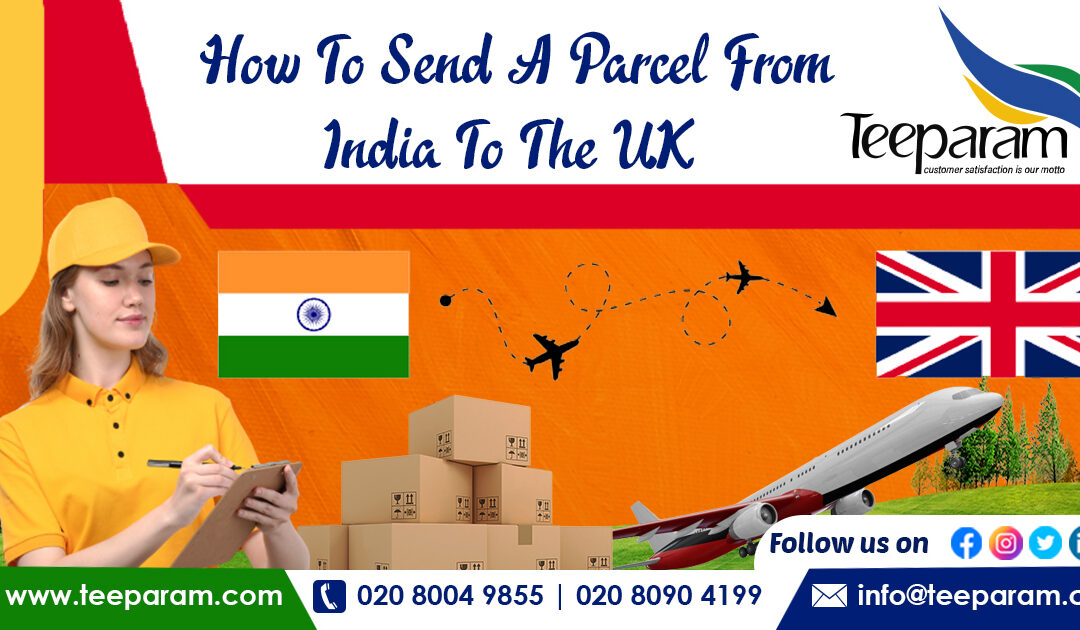
by Web Admin | Oct 5, 2023 | Blog
It can be challenging to send parcel from India, and there are a number of concerns that need to be answered beforehand. Whenever we wish to ship a parcel, a number of standard queries arise, including those pertaining to the package, the permitted weight, the pricing, and many more. However, you do not have to worry since in today’s blog, we will address all of these and more, and also discuss why Teeparam is your best option for sending parcels to the UK.
The Steps Involved
Prior to examining the reasons why Teeparam is the most suitable option for dispatching packages from India to the United Kingdom, it is imperative to comprehend the basic steps and factors associated with overseas shipping.
- Prior to sending a package, it is important to do a thorough examination of the intended item for shipment. It is advised to refrain from accepting packages from unfamiliar individuals. In the case of boxes sent by acquaintances, it is recommended to take caution by carrying out a thorough check as a means of avoiding potential complications or adverse consequences in future.
- Once the goods have been checked or verified, it is advisable to calculate the weight and dimensions of the package. This information is crucial for identifying an appropriate courier service provider and evaluating the associated costs and potential restrictions. It is vital to consistently verify whether the destination country possesses any legal impediments pertaining to the receipt or prohibition of the product being dispatched.
- Upon completion of the initial phases and establishing clarity regarding the intended content, the subsequent course of action involves selecting a suitable courier partner. When making a purchasing decision, it is crucial to evaluate many factors such as the price of the product, the delivery time, and most significantly, the availability of delivery services to your specific region.
- Many courier partners typically recommend that customers create their own packing. However, if individuals lack confidence in their packaging skills or have concerns about the safety of their goods, they should not hesitate to request additional protection from the courier partners.
- Please ensure that you accurately complete the necessary details, including your name, address, and recipient address, and take the time to double-check them for accuracy. It helps to ensure that the recipients do not return the item in the event of a failed delivery.
- Indicate whether the package is delicate and requires further precautions. Providing advance notice allows courier partners to classify your product and make necessary preparations accordingly.
How Is Teeparam Better?
Experts
Teeparam has demonstrated a notable record in the field of international shipping, positioning them as a very suitable option for ensuring the secure and timely delivery of your packages. Having accumulated years of experience, they have acquired specialisation in the complexities of cross border shipping, encompassing their skilled handling of customs rules and proficient management of foreign documentation.
Fair Pricing
The overseas shipment of parcels regularly incurs significant costs. However, Teeparam recognises the need of providing affordable alternatives. The service offered by the company maintains a high level of quality while remaining cost competitive. The cost-effectiveness renders them a preferred option for both individuals and organisations.
Dependable And Safe
Teeparam prioritises the security and safety of packages. The company’s dedication to employing secure packaging methods and implementing innovative tracking systems guarantees the safe and timely delivery of your things to their intended destination in the United Kingdom, without harm occurring.
Various Shipping Methods
Teeparam recognises the individuality of each shipping requirement and addresses this by providing a diverse selection of shipping alternatives. Teeparam offers a range of services designed to meet the specific requirements of customers, whether they necessitate expedited delivery for time-sensitive packages or a more cost-effective option for less time-critical shipments.
Convenience
Teeparam acknowledges the importance of convenience in modern life. The company provides convenient online booking and tracking services, which streamline the process of managing shipments by reducing the need for extensive paperwork. Additionally, these services allow real-time visibility into the course of your delivery.
Customer Support
Teeparam places a significant emphasis on delivering exceptional customer assistance, hence fostering a sense of pride in how they provide services. If there are any inquiries, apprehensions, or complications that arise during the transportation process, the customer service crew is promptly accessible to provide assistance.
Global Network
Teeparam’s broad network of partners and carriers enables the delivery of parcels to even the most relatively isolated regions within the United Kingdom. The extensive network enables efficient management of shipping requirements, regardless of the intended location.
Choose Teeparam
When considering the shipment of parcels from India to the United Kingdom, Teeparam emerges as the preferred option. Teeparam provides an entire shipping solution that ensures a smooth and dependable experience. Owing to their vast expertise in international shipping, affordable pricing, dedication to security, diverse range of shipping options.
Great customer care, and global network. Teeparam is a reliable and trustworthy option to send parcel to sri lanka. By entrusting your shipments to Teeparam, you can be confident that they will be delivered to their intended destinations in the United Kingdom securely and efficiently.

by Web Admin | Sep 30, 2023 | Blog
In contemporary society, where the prompt and secure transportation of packages, paperwork, and merchandise has utmost importance. The selection of an appropriate courier company can significantly impact outcomes. Teeparam has evolved as a prominent courier service provider in the United Kingdom. amidst the wide variety of available options. In today’s blog, we will examine the numerous factors that establish Teeparam as the top courier company in the United Kingdom.
Exceptional Reliability
Teeparam’s exceptional reputation is mostly due to its exemplary reliability. The company demonstrates a high level of care and dedication in handling every parcel, document, or cargo. Teeparam recognises the importance of timely deliveries and continually strives to surpass customer expectations by ensuring rapid delivery of all shipments.
A Broad and Efficient System
Teeparam’s geographical coverage encompasses the entirety of the United Kingdom, encompassing both densely populated urban areas and the most isolated rural regions. The wide and well-connected network possessed by the organisation ensures that even the most remote or challenging destinations can be accessed without difficulty. The extensive range of services provided by Teeparam enables the company to effectively cater to the varied requirements of its clientele.
Adaptable to a Wide Range of Demands
What sets Teeparam different is its ability to deliver customised solutions for a wide range of courier needs. Teeparam offers a comprehensive range of services to cater to various logistical needs. Which includes quick parcel delivery, transportation of delicate or vulnerable objects. And specialised services tailored for corporations. The trustworthy partnership they establish with a diversified clientele is attributed to their adaptability and flexibility.
Advanced Technology
Teeparam is a leading entity within the business, utilising modern technology to optimise efficiency and promote transparency. The company’s advanced tracking technologies provide consumers with immediate access to up-to-date information regarding the status and whereabouts of their goods. The degree of transparency demonstrated by Teeparam serves as evidence of their dedication to delivering a consumer experience that is both smooth and reassuring.
Competitive Pricing
Despite its dedication to delivering high-quality service. Teeparam maintains a strong commitment to maintaining competitive prices. The pricing structure is intentionally set at a reasonable level. With the aim of making their services accessible to a variety of clients. This includes people with occasional courier needs as well as enterprises spanning various scales. The level of value provided by our offerings is unmatched within the industry.
The Customer Spotlight
The primary factor contributing to Teeparam’s achievements lies in its steadfast commitment to ensuring client happiness. The customer support crew is consistently available and approachable, offering assistance, addressing concerns, and providing guidance. Teeparam places great importance on cultivating constructive and beneficial engagements with each customer, forming a cultivating sense of trust and commitment.
Environmental Sustainability
Teeparam acknowledges the crucial importance of sustainability in the present global context. The company has implemented proactive measures to fulfil its environmental responsibilities, which encompass the adoption of efficient route planning, vehicle optimisation strategies, and the utilisation of environmentally conscious automobiles. These sustainability activities are in accordance with the principles of customers who prioritise ecologically responsible company practises.
Deliver Next With Teeparam
Amidst a competitive market of courier services in UK, Teeparam has achieved remarkable success, establishing itself as the foremost courier firm in the United Kingdom. The company’s consistent dependability, expansive network, wide range of services, technological innovations, competitive pricing, customer-focused values, and dedication to sustainability establish them as the unquestioned frontrunners in the business.
Teeparam is not solely limited to being a courier service, but rather functions as a reliable collaborator that possesses a deep understanding of the distinct needs of every client and continually delivers remarkable results. Teeparam is widely regarded as an ideal example of professionalism and reliability, whether it pertains to a crucial corporate consignment or a personal package. In the realm of parcel and document delivery, Teeparam is a prominent figure, establishing itself as the epitome of excellence in courier services.
by Web Admin | May 31, 2019 | Blog
Have you heard of parcel shipping?
What is parcel shipping? Parcel shipping or parcel delivery is the delivery of
shipping containers, parcels or high-value mail as single shipments. These
services are offered by most postal systems, private courier companies or
express mail. These are too heavy compared to a normal letter post. While
you’re going to avail the service of parcel shipping, you need to consider the
following points:
- Safety
of your parcel is most vital.
- Choose
which documents and items need to be sent through parcel shipping because the
damage or loss of documents can be paramount and in some cases, the loss is
unrecoverable.
- Be
clear about the motive of your availing parcel shipping service
- Check
out for the insurance cover
- Check
out for the online tracking of your shipment
- Analyze
the urgency of your sending the items and documents through parcel shipping
- Never
get tapped by cheap rates. Give importance to the standard of service and
security of your belongings.
With the digitization of the parcel
system and the rise of e-commerce, the demand for parcel service has been
raised manifold and the shippers are struggling to secure available capacity
and affordable rates. The shippers need to know the top trends for parcel
shipping in 2019 so that they can develop their logistics strategies and
control the logistics spend. Read the following few trends:
1.
Faster and Easier Pickup: Faster
and easier pick up, on time or next day delivery will continue to be vital in
2019. The idea is to bring packages closer to consumers and the ultimate
delivery destination. Pop-up distribution centers, self-service kiosks, buying
online and pick up in-store (BOPIS) delivery options are becoming very
important for parcel management.
2.
Parcel-the Most-Valuable Part of
E-Commerce Shipping: With the rise
of the value of parcel logistics, it is getting essential for successful
e-commerce practices. As the market is increasingly competitive and the rates
are soaring high, the shipper will begin to cut down their price even at the
cost of their profitability. That means there will be a trend in 2019 which
would revolve around the use of predictive analytics to proactively manage
parcel operations throughout the warehouse and the logistics network. The
process can be applied to carriers to meet their standards and delivery
expectations.
3.
More demand for faster delivery: There will be rising demand for faster
delivery and consumers will increasingly go for paying a premium for faster
delivery. This could one of the significant change in how the carriers and
shippers will approach parcel shipping.
4. Use of Big Data Analytics for Customer Awareness: There is a steady increase in logistics costs across the spectrum. This is due to diminished capacity and tightening driver availability. So, the companies are trying to reduce the costs and want to meet the consumer demands by all means. The companies are using big data analytics to understand consumer awareness.
5. Use Self-Service Kiosks by Carriers to Reach More Shippers: Self-service kiosks are used to access parcels. They’re commonly associated with the pickup leg of logistic. The carriers will implement more and more self-service kiosks so that shippers will have the freedom to send packages last-minute and without the delays of manual paperwork.
by Web Admin | May 22, 2019 | Blog
In today’s globally competitive business world, high-quality production, large client-base, and efficient employees are not enough to survive in the hard-hitting business atmosphere. Safe, reliable and on-time delivery of the goods is one of the important aspects of the business. It won’t be possible for any business to depend solely on its labor resources for either transporting the raw materials or distributing the final products.
They tend to rely on third-party professional delivery services for sipping letters, business documents, parcels, and most importantly their produced goods to different parts of the world.
Significance of parcel services for global business
The global business world tends to be fast and competitive. For faster growth and prosperity, it is imperative for the businesses to deliver their products and packages more quickly and safely to their desired destination. Gone are the days when the consumers had to wait for days to receive their products and packages. Nowadays, the companies are relying on the professional and well-equipped courier and parcel services in order to outsource their consignment delivery as soon as possible.
The role of parcel services is becoming increasingly important because the customers demand their products and packages to be delivered within one or two days of booking of the consignment. If you’re manufacturing a high-quality product and you won’t able to deliver on-time, rest of the efforts would amount to be wasted. Parcel delivery is the easiest and the most convenient way of transferring your important documents, files, Gifts, and other items.
Advantages of Professional parcel services
The feature that makes the parcel service most desirable is the tracking code or the customer ID, which the customer gets after submitting the parcel to the delivery company. The customer can easily check the status and location of its parcel from anywhere by logging onto the delivery company website and putting the customer ID in the required field.
The parcel services are regarded as the most simplified and the latest innovations of the global logistics world. It’s cost-effective and makes the lesser use of manpower. When it comes to delivering the products and goods to their target destination, the parcel services are considered as the backbone of businesses. Their same or next day delivery, express, and safe delivery services are trademark services which are playing a vital role in day to day functioning of businesses all across the globe.
The professional courier services give values to their customers and take the full safety of the customer consignments and fast delivery. Businesses across the globe are benefited from the discount offered by the international courier companies that bring cost-effectiveness to the overall cost of the product. Most of the courier companies would insure damages that may occur during transport or shipment, along with the record of all information about the package that is to be delivered to the customer.
Tips for choosing high-quality parcel service
- Availability of 24*7 customer help service
- Check the weight limitation of the package before booking the consignment
- Ability to track your consignment online
• Get insurance for your package

by Web Admin | Mar 20, 2019 | Blog
Online shopping mode or e-commerce websites are becoming increasing popular and have done remarkably well in recent times among buyers. Thanks to their unique styles of the product display, methods to improve the headcount and flexible payment options have contributed a lot to the growing popularity of online shopping. As the competition is increasing, these online shopping companies keep on adding new features to their sites according to changing requirements and demands of the customers.

Buying products or availing services online is very exciting these days, making markets and shopping malls quieter and online stores are jam-packed with full-of digital shoppers as the new innovations are popping up every day. There are many factors which are pointing 2019 to be the year of change for UK retail sector. E-commerce industry will realize the importance of customer-centric approach and end-to-end delivery. There are other things such as ‘fast and free’ delivery, delivery options that are customizable and transparent and prioritizing customer convenience.
Some of the hottest trends that can rule 2019 include:
Personalization
E-commerce is always personalized. It seems to get more personalized in 2019. How can it be more personalized? Brands have to provide exact delivery information, which fits to a particular location and customers. Amazon is the biggest example of the personalized e-commerce delivery. If you want to buy a new brand of wedding costume, once we made the selection, Amazon will calculate the exact delivery time based w.r.t our IP address. Then he will mention the cut-off time for our location with a countdown timer within which you have to order.
Amazon also makes the delivery user-friendly by making the delivery dates clear-cut by stating the calendar date rather than the shipping speed. For example they mention Wednesday 5th March- Thursday 6th March. Personalizing delivery means making the customers know exactly when their items will arrive, eliminating the uncertainty.
Guided by Automation to remove delivery complexities
Retailers or online sellers have to know what to automate during the delivery and logistics process. For example, if you have broad portfolio of products, it can create complexity. First, real challenge comes how you can match up to the right delivery type and carrier to individual items. Next, how you can automate that process during checkout?
You have to depend upon plugging in an automation tool- that is a powerful rule-based engine in order to consider a number of things instantaneously. For example, the product types, the basket mix, order of destination etc. Therefore, the rule-based system would automatically show the appropriate delivery options.
Convenient Pickup Points
Every customer wants cheap and fast delivery. But there’s a limit to the cheap and fast delivery. An efficient, cost-effective and err-free delivery can be obtained through find a pickup point or location that is convenient for customers, mentioned by customers themselves. E-commerce giant Amazon has acquired supermarket chain Wholefoods and places their Amazon pick-up lockers in their stores.
Impact of Brexit
There’s great deal uncertainty related to Brexit in UK and its possible impact and outcome. For that, many industries have been remained standstill. But research from various freight solutions indicate that online retailers are exploring growth opportunities outside of Europe, in view of uncertainty and complex trade regulations that may arise. But there’s considerable indication that UK retailers are expected to increase international revenue in 2019.
Accurate Delivery
Customers always want more accurate delivery from online retailers. Most of the brands are now going by the nominated-day of deliver, which is very exciting and helpful. This year,, you expect to see more priority from brands as far as customer convenience is concerned by offering nominated time slots.
Future Delivery Trends
In spite of so much buzz around the matchless delivery system, health and safety, robustness of the delivery solution would decide the future of possible delivery trends. It’s about how online retailers stay pragmatic and having the flexibility to change with the market demands, offering customers relevant series of options which they find easy-to-use and simple to purchase However, where delivery is concerned, retailers have to find right partners, in terms of cargo and courier services.





